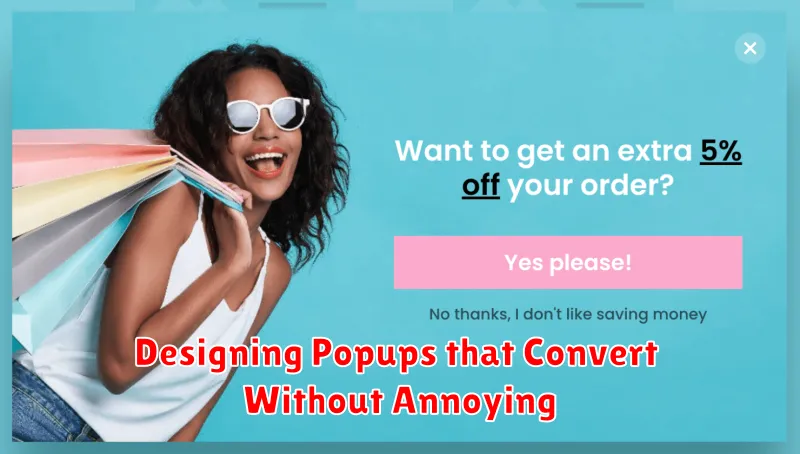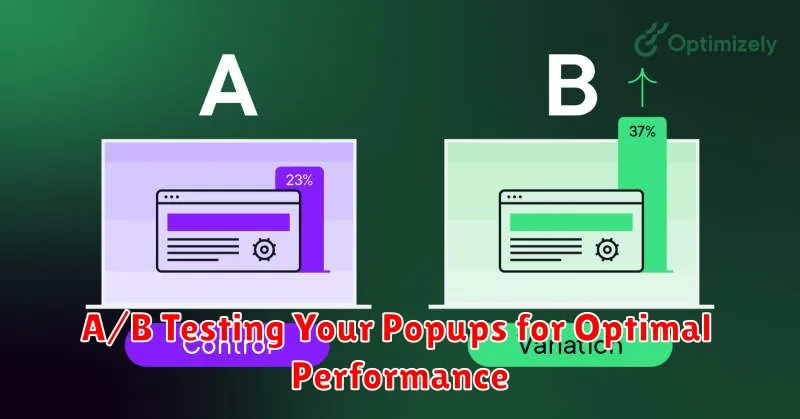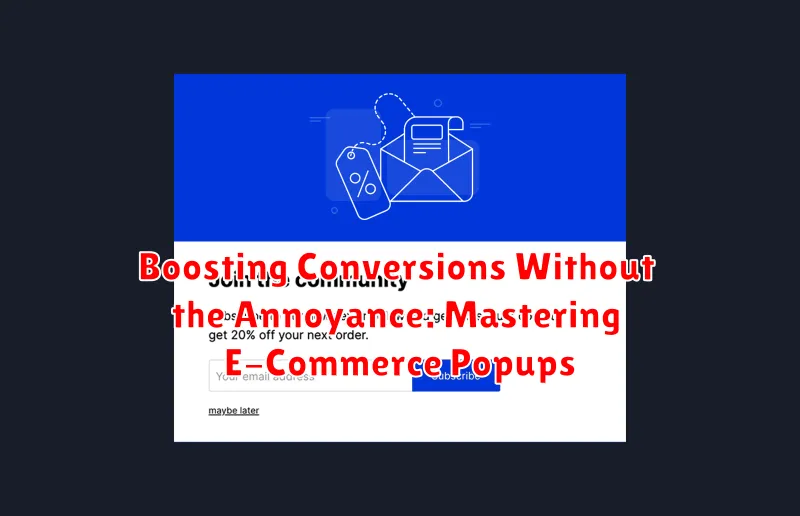E-commerce popups, when done right, can significantly boost conversions. However, they often walk a fine line between being effective marketing tools and annoying interruptions. This article explores the strategies for mastering e-commerce popups, enabling you to effectively engage visitors and increase sales without driving them away. We’ll delve into the nuances of timing, targeting, and design, transforming your popups from disruptive distractions into valuable opportunities for conversion rate optimization.
Learn how to leverage the power of popups without sacrificing user experience. Discover how to create high-converting popups that capture leads, promote special offers, and ultimately boost your bottom line. From understanding the psychology of popups to implementing best practices for design and content, this guide will provide you with the essential knowledge to implement effective popup strategies that resonate with your audience and deliver tangible results. Stop annoying your customers and start converting them with strategically implemented e-commerce popups.
The Power of Popups (When Used Correctly)
Popups, often perceived as intrusive, can be a powerful tool for driving conversions when implemented strategically. They offer a direct channel to communicate with website visitors, capturing their attention and presenting targeted offers or information.
Effective popups capitalize on key moments in the customer journey. By appearing at the right time with the right message, they can significantly impact user behavior. This includes encouraging email sign-ups, promoting special deals, or reducing cart abandonment.
The key to leveraging popup power lies in finding a balance between visibility and user experience. Non-intrusive, well-designed popups that offer genuine value are more likely to be received positively and contribute to increased engagement and sales.
Types of E-Commerce Popups and Their Use Cases
Several types of popups cater to different marketing objectives. Choosing the right one is crucial for maximizing effectiveness.
Email Opt-in Popups:
These are designed to capture visitor email addresses. Offer an incentive like a discount code or exclusive content in exchange for signing up.
Promotional Popups:
Highlight special offers, new product arrivals, or seasonal promotions. These popups create a sense of urgency and encourage immediate action.
Exit-Intent Popups:
Triggered when a visitor is about to leave your website. Offer a last-minute discount or incentive to stay and complete a purchase. This can be a powerful tool for recovering potentially lost sales.
Survey Popups:
Gather valuable customer feedback about their website experience or product preferences. Use this information to improve your offerings and customer journey.
Targeted Popups:
These are shown to specific segments of your audience based on their browsing behavior, purchase history, or demographics. This allows for more personalized messaging and relevant offers.
Designing Popups that Convert Without Annoying

Effective popup design hinges on a delicate balance: capturing attention while respecting the user experience. Visual appeal is key. Employ clean, uncluttered designs with a clear hierarchy of information. Concise and compelling copy is crucial; get to the point quickly and highlight the value proposition.
Strategic use of color and imagery can enhance the popup’s effectiveness. Align these elements with your brand identity for consistency and recognition. Mobile responsiveness is paramount. Ensure your popups render correctly on all devices, adapting to different screen sizes without obstructing content.
A prominent and easily accessible close button is essential. Users should feel in control and be able to dismiss the popup effortlessly. Avoid aggressive design tactics like flashing animations or difficult-to-locate close buttons, which can quickly frustrate visitors.
Best Practices for Popup Timing and Placement
Timing and placement are crucial for popup effectiveness. A poorly timed popup can disrupt the user experience and drive customers away. Conversely, a well-timed popup can significantly boost conversions.
Avoid immediate popups. Give visitors a chance to explore your site before presenting a popup. A good starting point is to trigger the popup after a few seconds of engagement or when a user scrolls a certain percentage down the page.
Consider exit-intent popups. These popups appear when a user’s cursor moves towards the close button or address bar, offering a last-chance discount or incentive to stay. They can be highly effective in recovering potentially lost sales.
Strategic placement matters. Popups should be visually prominent without obstructing essential content. Centered popups are generally effective, but consider slide-in popups from the bottom or side for a less intrusive approach.
Targeting the Right Customers with Personalized Popups
Generic popups can feel intrusive. Targeted popups, however, offer a tailored experience that resonates with individual customer needs. This involves segmenting your audience and crafting popups specific to their interests and behaviors.
Consider these targeting strategies:
- New Visitors: Greet new visitors with a welcome popup offering a first-purchase discount or free shipping.
- Returning Visitors: Offer personalized recommendations based on their browsing history or previous purchases.
- Shopping Cart Abandonment: Target users who’ve added items to their cart but haven’t checked out, offering a small incentive to complete their purchase.
- Geo-location: Tailor offers and promotions based on the visitor’s location.
- Page-Specific Targeting: Display popups relevant to the specific product or category page a user is viewing.
By analyzing customer data and using the right targeting parameters, you can deliver the right message to the right customer at the right time, significantly increasing the effectiveness of your popups.
A/B Testing Your Popups for Optimal Performance

A/B testing is crucial for optimizing your popup’s effectiveness. It allows you to compare two versions of a popup (A and B) to see which performs better. By making small, incremental changes, you can pinpoint the most effective strategies.
Key elements to test include:
- Headline: Test different headlines to see which grabs attention most effectively.
- Call to Action (CTA): Experiment with different CTA text, button colors, and placement.
- Offer: Compare different incentives, such as discounts, free shipping, or exclusive content.
- Design: Test variations in layout, imagery, and overall aesthetic.
- Targeting: Experiment with displaying popups based on different user behavior, such as time spent on page or pages viewed.
Analyze the results of your A/B tests to determine which version yields the highest conversion rate. Use this data to refine your popups and continuously improve their performance. Remember to test one element at a time for clear, actionable results.
Integrating Popups with Your Email Marketing Strategy
Email marketing and popups can work synergistically to boost your subscriber list and drive conversions. Use popups to capture email addresses directly, seamlessly integrating them into your email marketing platform.
Offer exclusive incentives within your popups to encourage sign-ups. Think discounts, free shipping, or access to exclusive content. This provides immediate value to the customer and strengthens their motivation to subscribe.
Segment your audience based on the popup they interacted with. For example, if a customer signs up through a popup promoting a specific product category, tailor future email campaigns to feature relevant items. This personalized approach can significantly improve conversion rates.
Use exit-intent popups to recapture potentially lost customers. Offer a final incentive, like a discount code, to encourage them to complete their purchase or at least join your email list for future offers.
Measuring the Success of Your Popup Campaigns
Effectively measuring your popup campaigns is crucial for understanding their impact and optimizing for better results. Don’t just implement popups and hope for the best; track key metrics to gauge their true effectiveness.
Conversion Rate: This is the most important metric. Track how many visitors who see your popup complete the desired action, whether it’s signing up for your newsletter or claiming a discount. A higher conversion rate indicates a successful campaign.
Close Rate: While seemingly negative, the close rate helps you understand how many visitors dismiss your popup. A high close rate might indicate that your popup is disruptive or irrelevant to the user’s current browsing session.
Time on Page/Site: Analyze if your popups impact how long visitors stay on your website. A significant decrease might suggest that your popups are intrusive and driving users away.
Bounce Rate: Monitor your site’s bounce rate after implementing popups. A sudden increase could indicate that your popups are deterring visitors from exploring further.
By analyzing these metrics, you can identify what works and what doesn’t, allowing you to fine-tune your popup campaigns for optimal performance and increased conversions.
Common Popup Mistakes to Avoid
While popups can be effective, deploying them incorrectly can harm user experience and drive potential customers away. Avoiding these common mistakes is crucial for successful popup campaigns.
Overwhelming Frequency: Bombarding visitors with popups the moment they arrive, and then repeatedly throughout their browsing session, creates a frustrating experience. Implement frequency capping to limit the number of times a user sees a popup within a given timeframe.
Obscuring Content: Popups that entirely block the content a user is trying to access are disruptive and counterproductive. Opt for smaller, less intrusive designs or exit-intent popups that appear as the user is leaving the page.
Difficult to Close: A tiny or hidden close button forces users to hunt for a way out, leading to annoyance. Ensure the close button is clearly visible and easily clickable.
Irrelevant Offers: Generic popups that don’t align with the user’s interests or browsing history are ineffective. Target your popups based on user behavior and offer relevant promotions or content.
Ignoring Mobile Optimization: Popups that don’t render correctly on mobile devices disrupt the user experience and can even make it impossible to navigate the site. Always ensure your popups are mobile-friendly and responsive.

